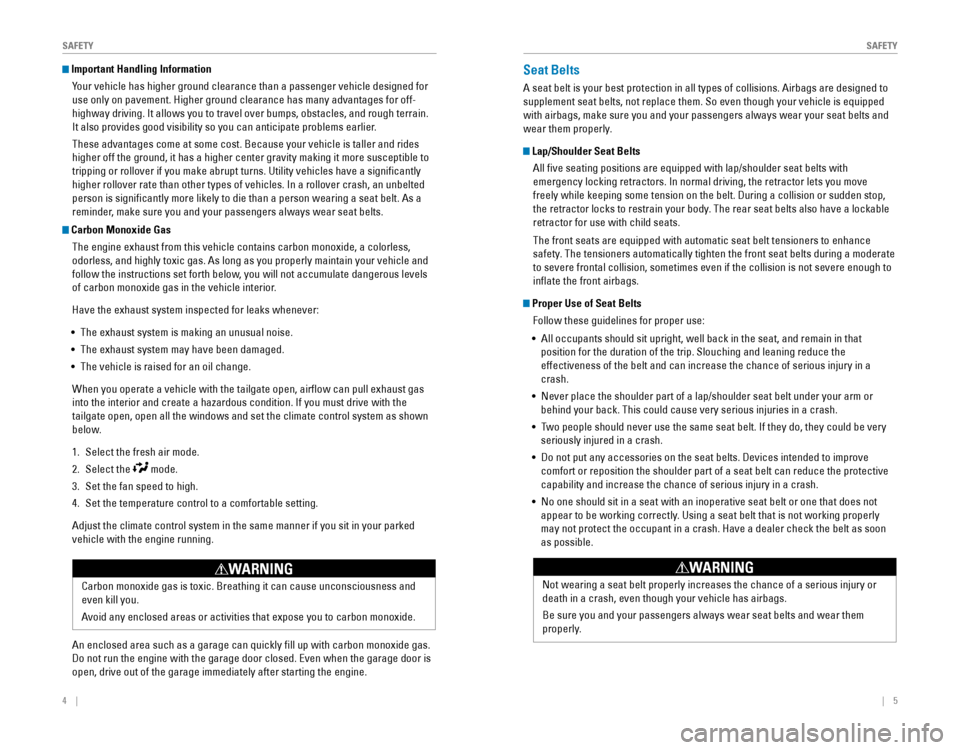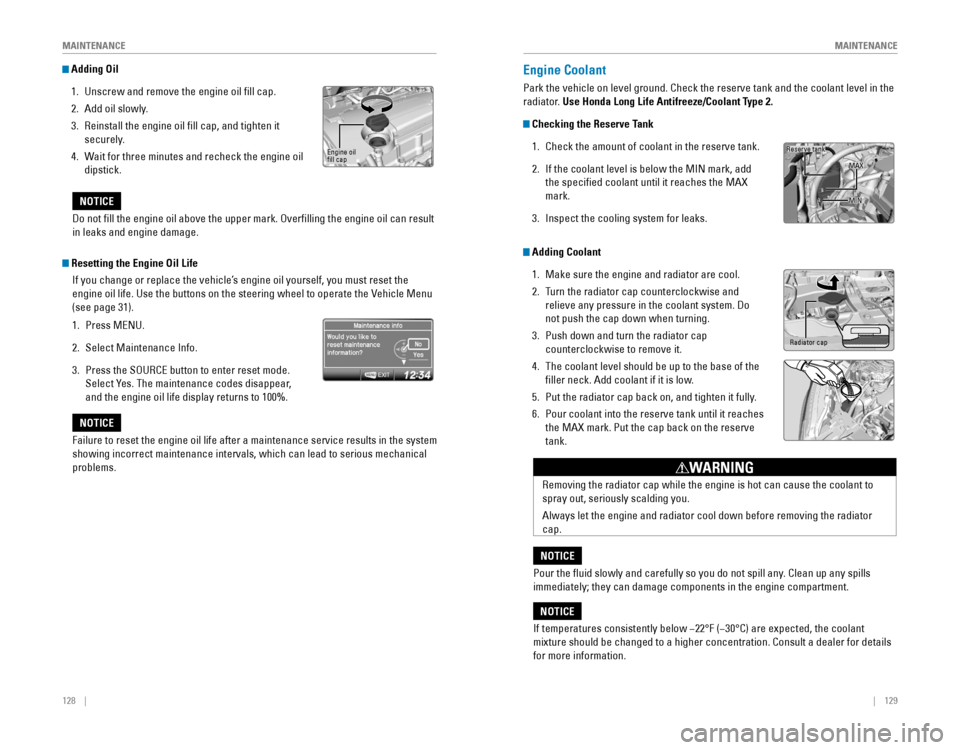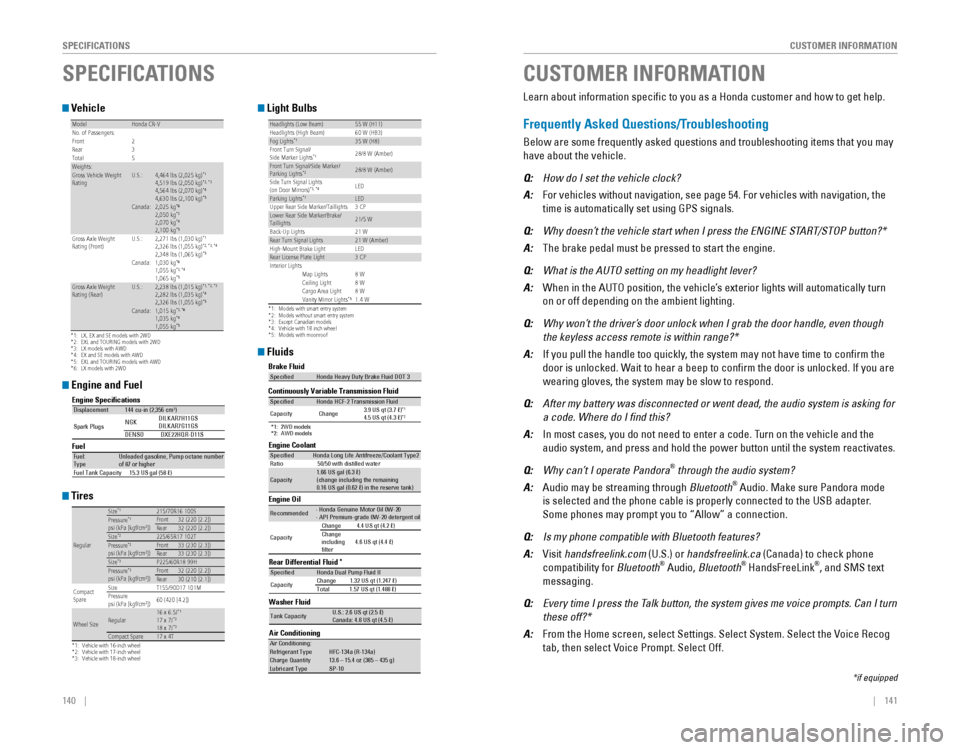oil type HONDA CR-V 2016 RM1, RM3, RM4 / 4.G Quick Guide
[x] Cancel search | Manufacturer: HONDA, Model Year: 2016, Model line: CR-V, Model: HONDA CR-V 2016 RM1, RM3, RM4 / 4.GPages: 80, PDF Size: 7.99 MB
Page 6 of 80

4‚Äā‚Äā‚Äā‚Äā|| 5
S
AFETYSAFETY
Carbon Monoxide Gas
The‚Äāengine‚Äāexhaust‚Äāfrom‚Äāthis‚Äāvehicle‚Äācontains‚Äācarbon‚Äāmonoxide,‚Äāa‚Äācolorless,‚Äā
odorless, and highly toxic gas. As long as you properly maintain your ve\
hicle and
follow‚Äāthe‚Äāinstructions‚Äāset‚Äāforth‚Äābelow,‚Äāyou‚Äāwill‚Äānot‚Äāaccumulate‚Äādangerous‚Äālevels‚Äā
of‚Äācarbon‚Äāmonoxide‚Äāgas‚Äāin‚Äāthe‚Äāvehicle‚Äāinterior.
Have the exhaust system inspected for leaks whenever:
‚ÄĘ‚Äā The exhaust system is making an unusual noise.
‚ÄĘ‚Äā
The‚Äāexhaust‚Äāsystem‚Äāmay‚Äāhave‚Äābeen‚Äādamaged.
‚ÄĘ‚Äā The vehicle is raised for an oil change.
When you operate a vehicle with the tailgate open, airflow can pull ex\
haust gas
into‚Äāthe‚Äāinterior‚Äāand‚Äācreate‚Äāa‚Äāhazardous‚Äācondition.‚ÄāIf‚Äāyou‚Äāmust‚Äādrive‚Äāwith‚Äāthe‚Äā
tailgate open, open all the windows and set the climate control system a\
s shown
below.
1. Select the fresh air mode.
2. Select the mode.
3. Set the fan speed to high.
4.‚ÄāSet‚Äāthe‚Äātemperature‚Äācontrol‚Äāto‚Äāa‚Äācomfortable‚Äāsetting.
Adjust the climate control system in the same manner if you sit in your \
parked
vehicle with the engine running.
An‚Äāenclosed‚Äāarea‚Äāsuch‚Äāas‚Äāa‚Äāgarage‚Äācan‚Äāquickly‚Äāfill‚Äāup‚Äāwith‚Äācarbon‚Äāmonoxide‚Äāgas.‚Äā
Do‚Äānot‚Äārun‚Äāthe‚Äāengine‚Äāwith‚Äāthe‚Äāgarage‚Äādoor‚Äāclosed.‚ÄāEven‚Äāwhen‚Äāthe‚Äāgarage‚Äādoor‚Äāis‚Äā
open, drive out of the garage immediately after starting the engine.
Seat Belts
A‚Äāseat‚Äābelt‚Äāis‚Äāyour‚Äābest‚Äāprotection‚Äāin‚Äāall‚Äātypes‚Äāof‚Äācollisions.‚ÄāAirbags‚Äāare‚Äādesigned‚Äāto‚Äā
supplement‚Äāseat‚Äābelts,‚Äānot‚Äāreplace‚Äāthem.‚ÄāSo‚Äāeven‚Äāthough‚Äāyour‚Äāvehicle‚Äāis‚Äāequipped‚Äā
with‚Äāairbags,‚Äāmake‚Äāsure‚Äāyou‚Äāand‚Äāyour‚Äāpassengers‚Äāalways‚Äāwear‚Äāyour‚Äāseat‚Äābelts‚Äāand‚Äā
wear them properly.
Lap/Shoulder Seat Belts
All‚Äāfive‚Äāseating‚Äāpositions‚Äāare‚Äāequipped‚Äāwith‚Äālap/shoulder‚Äāseat‚Äābelts‚Äāwith‚Äā
emergency‚Äālocking‚Äāretractors.‚ÄāIn‚Äānormal‚Äādriving,‚Äāthe‚Äāretractor‚Äālets‚Äāyou‚Äāmove‚Äā
freely‚Äāwhile‚Äākeeping‚Äāsome‚Äātension‚Äāon‚Äāthe‚Äābelt.‚ÄāDuring‚Äāa‚Äācollision‚Äāor‚Äāsudden‚Äāstop,‚Äā
the‚Äāretractor‚Äālocks‚Äāto‚Äārestrain‚Äāyour‚Äābody.‚ÄāThe‚Äārear‚Äāseat‚Äābelts‚Äāalso‚Äāhave‚Äāa‚Äālockable‚Äā
retractor for use with child seats.
The‚Äāfront‚Äāseats‚Äāare‚Äāequipped‚Äāwith‚Äāautomatic‚Äāseat‚Äābelt‚Äātensioners‚Äāto‚Äāenhance‚Äā
safety.‚ÄāThe‚Äātensioners‚Äāautomatically‚Äātighten‚Äāthe‚Äāfront‚Äāseat‚Äābelts‚Äāduring‚Äāa‚Äāmoderate‚Äā
to severe frontal collision, sometimes even if the collision is not seve\
re enough to
inflate‚Äāthe‚Äāfront‚Äāairbags.
Proper Use of Seat Belts Follow these guidelines for proper use:
‚ÄĘ‚Äā
All‚Äāoccupants‚Äāshould‚Äāsit‚Äāupright,‚Äāwell‚Äāback‚Äāin‚Äāthe‚Äāseat,‚Äāand‚Äāremain‚Äāin‚Äāthat‚Äā
position for the duration of the trip. Slouching and leaning reduce the \
effectiveness‚Äāof‚Äāthe‚Äābelt‚Äāand‚Äācan‚Äāincrease‚Äāthe‚Äāchance‚Äāof‚Äāserious‚Äāinjury‚Äāin‚Äāa‚Äā
crash.
‚ÄĘ‚Äā
Never‚Äāplace‚Äāthe‚Äāshoulder‚Äāpart‚Äāof‚Äāa‚Äālap/shoulder‚Äāseat‚Äābelt‚Äāunder‚Äāyour‚Äāarm‚Äāor‚Äā
behind‚Äāyour‚Äāback.‚ÄāThis‚Äācould‚Äācause‚Äāvery‚Äāserious‚Äāinjuries‚Äāin‚Äāa‚Äācrash.
‚ÄĘ‚ÄāTwo‚Äāpeople‚Äāshould‚Äānever‚Äāuse‚Äāthe‚Äāsame‚Äāseat‚Äābelt.‚ÄāIf‚Äāthey‚Äādo,‚Äāthey‚Äācould‚Äābe‚Äāvery‚Äā
seriously injured in a crash.
‚ÄĘ‚Äā
Do‚Äānot‚Äāput‚Äāany‚Äāaccessories‚Äāon‚Äāthe‚Äāseat‚Äābelts.‚ÄāDevices‚Äāintended‚Äāto‚Äāimprove‚Äā
comfort‚Äāor‚Äāreposition‚Äāthe‚Äāshoulder‚Äāpart‚Äāof‚Äāa‚Äāseat‚Äābelt‚Äācan‚Äāreduce‚Äāthe‚Äāprotective‚Äā
capability‚Äāand‚Äāincrease‚Äāthe‚Äāchance‚Äāof‚Äāserious‚Äāinjury‚Äāin‚Äāa‚Äācrash.
‚ÄĘ‚ÄāNo‚Äāone‚Äāshould‚Äāsit‚Äāin‚Äāa‚Äāseat‚Äāwith‚Äāan‚Äāinoperative‚Äāseat‚Äābelt‚Äāor‚Äāone‚Äāthat‚Äādoes‚Äānot‚Äā
appear‚Äāto‚Äābe‚Äāworking‚Äācorrectly.‚ÄāUsing‚Äāa‚Äāseat‚Äābelt‚Äāthat‚Äāis‚Äānot‚Äāworking‚Äāproperly‚Äā
may‚Äānot‚Äāprotect‚Äāthe‚Äāoccupant‚Äāin‚Äāa‚Äācrash.‚ÄāHave‚Äāa‚Äādealer‚Äācheck‚Äāthe‚Äābelt‚Äāas‚Äāsoon‚Äā
as‚Äāpossible.
Important Handling Information Your vehicle has higher ground clearance than a passenger vehicle designe\
d for
use only on pavement. Higher ground clearance has many advantages for of\
f-
highway‚Äādriving.‚ÄāIt‚Äāallows‚Äāyou‚Äāto‚Äātravel‚Äāover‚Äābumps,‚Äāobstacles,‚Äāand‚Äārough‚Äāterrain.‚Äā
It‚Äāalso‚Äāprovides‚Äāgood‚Äāvisibility‚Äāso‚Äāyou‚Äācan‚Äāanticipate‚Äāproblems‚Äāearlier.
These advantages come at some cost. Because your vehicle is taller and rides
higher‚Äāoff‚Äāthe‚Äāground,‚Äāit‚Äāhas‚Äāa‚Äāhigher‚Äācenter‚Äāgravity‚Äāmaking‚Äāit‚Äāmore‚Äāsusceptible‚Äāto‚Äā
tripping‚Äāor‚Äārollover‚Äāif‚Äāyou‚Äāmake‚Äāabrupt‚Äāturns.‚ÄāUtility‚Äāvehicles‚Äāhave‚Äāa‚Äāsignificantly‚Äā
higher‚Äārollover‚Äārate‚Äāthan‚Äāother‚Äātypes‚Äāof‚Äāvehicles.‚ÄāIn‚Äāa‚Äārollover‚Äācrash,‚Äāan‚Äāunbelted‚Äā
person‚Äāis‚Äāsignificantly‚Äāmore‚Äālikely‚Äāto‚Äādie‚Äāthan‚Äāa‚Äāperson‚Äāwearing‚Äāa‚Äāseat‚Äābelt.‚ÄāAs‚Äāa‚Äā
reminder,‚Äāmake‚Äāsure‚Äāyou‚Äāand‚Äāyour‚Äāpassengers‚Äāalways‚Äāwear‚Äāseat‚Äābelts.
Carbon‚Äāmonoxide‚Äāgas‚Äāis‚Äātoxic.‚ÄāBreathing‚Äāit‚Äācan‚Äācause‚Äāunconsciousness‚Äāand‚Äā
even kill you.
Avoid‚Äāany‚Äāenclosed‚Äāareas‚Äāor‚Äāactivities‚Äāthat‚Äāexpose‚Äāyou‚Äāto‚Äācarbon‚Äāmonoxide.
WARNING
Not‚Äāwearing‚Äāa‚Äāseat‚Äābelt‚Äāproperly‚Äāincreases‚Äāthe‚Äāchance‚Äāof‚Äāa‚Äāserious‚Äāinjury‚Äāor‚Äā
death‚Äāin‚Äāa‚Äācrash,‚Äāeven‚Äāthough‚Äāyour‚Äāvehicle‚Äāhas‚Äāairbags.
Be‚Äāsure‚Äāyou‚Äāand‚Äāyour‚Äāpassengers‚Äāalways‚Äāwear‚Äāseat‚Äābelts‚Äāand‚Äāwear‚Äāthem‚Äā
properly.
WARNING
Page 68 of 80

128 || 129
MAINTENANCE
MAINTENANCE
Adding Oil
1. Unscrew and remove the engine oil fill cap.
2. Add oil slowly.
3. Reinstall the engine oil fill cap, and tighten it
securely.
4.‚ÄāWait for three minutes and recheck the engine oil
dipstick.Engine‚Äāoil‚Äāfill cap
Do‚Äānot‚Äāfill‚Äāthe‚Äāengine‚Äāoil‚Äāabove‚Äāthe‚Äāupper‚Äāmark.‚ÄāOverfilling‚Äāthe‚Äāengine‚Äāoil‚Äācan‚Äāresult‚Äā
in leaks and engine damage.
NOTICE
Failure to reset the engine oil life after a maintenance service results\
in the system
showing incorrect maintenance intervals, which can lead to serious mecha\
nical
problems.
NOTICE
Resetting the Engine Oil Life
If‚Äāyou‚Äāchange‚Äāor‚Äāreplace‚Äāthe‚Äāvehicle‚Äôs‚Äāengine‚Äāoil‚Äāyourself,‚Äāyou‚Äāmust‚Äāreset‚Äāthe‚Äā
engine‚Äāoil‚Äālife.‚ÄāUse‚Äāthe‚Äābuttons‚Äāon‚Äāthe‚Äāsteering‚Äāwheel‚Äāto‚Äāoperate‚Äāthe‚ÄāVehicle‚ÄāMenu‚Äā
(see page 31).
1. Press‚ÄāMENU.
2. Select‚ÄāMaintenance‚ÄāInfo.
3. Press‚Äāthe‚ÄāSOURCE‚Äābutton‚Äāto‚Äāenter‚Äāreset‚Äāmode.
Select Yes. The maintenance codes disappear,
and‚Äāthe‚Äāengine‚Äāoil‚Äālife‚Äādisplay‚Äāreturns‚Äāto‚Äā100%.
Engine Coolant
Park the vehicle on level ground. Check the reserve tank and the coolant\
level in the
radiator. Use Honda Long Life Antifreeze/Coolant Type 2.
Checking the Reserve Tank
1. Check the amount of coolant in the reserve tank.
2. If‚Äāthe‚Äācoolant‚Äālevel‚Äāis‚Äābelow‚Äāthe‚ÄāMIN‚Äāmark,‚Äāadd‚Äā
the specified coolant until it reaches the MAX
mark.
3. Inspect‚Äāthe‚Äācooling‚Äāsystem‚Äāfor‚Äāleaks.
If‚Äātemperatures‚Äāconsistently‚Äābelow‚Äā‚ąí22¬įF‚Äā(‚ąí30¬įC)‚Äāare‚Äāexpected,‚Äāthe‚Äācoolant‚Äā
mixture‚Äāshould‚Äābe‚Äāchanged‚Äāto‚Äāa‚Äāhigher‚Äāconcentration.‚ÄāConsult‚Äāa‚Äādealer‚Äāfor‚Äādetails‚Äā
for more information.
NOTICE
Reserve tank
MAX
MIN
Removing the radiator cap while the engine is hot can cause the coolant \
to
spray out, seriously scalding you.
Always‚Äālet‚Äāthe‚Äāengine‚Äāand‚Äāradiator‚Äācool‚Äādown‚Äābefore‚Äāremoving‚Äāthe‚Äāradiator‚Äā
cap.
WARNING
Pour the fluid slowly and carefully so you do not spill any. Clean up any spills
immediately; they can damage components in the engine compartment.
NOTICE
Adding Coolant
1. Make sure the engine and radiator are cool.
2. Turn the radiator cap counterclockwise and
relieve‚Äāany‚Äāpressure‚Äāin‚Äāthe‚Äācoolant‚Äāsystem.‚ÄāDo‚Äā
not push the cap down when turning.
3. Push down and turn the radiator cap
counterclockwise to remove it.
4.‚ÄāThe‚Äācoolant‚Äālevel‚Äāshould‚Äābe‚Äāup‚Äāto‚Äāthe‚Äābase‚Äāof‚Äāthe‚Äā
filler neck. Add coolant if it is low.
5. Put‚Äāthe‚Äāradiator‚Äācap‚Äāback‚Äāon,‚Äāand‚Äātighten‚Äāit‚Äāfully.
6. Pour coolant into the reserve tank until it reaches
the‚ÄāMAX‚Äāmark.‚ÄāPut‚Äāthe‚Äācap‚Äāback‚Äāon‚Äāthe‚Äāreserve‚Äā
tank.
Radiator cap
Page 74 of 80

140‚Äā‚Äā‚Äā‚Äā||‚Äā‚Äā‚Äā‚Äā141
CUSTOMER INFORMATION
SPECIFICATIONS
Vehicle
*1:LX, EX and SE models with 2WD*2:EXL and TOURING models with 2WD*3:LX models with AWD*4:EX and SE models with AWD*5:EXL and TOURING models with AWD*6: LX models with 2WD
ModelHonda CR- VNo. of Passengers:
Front 2
Rear 3
Tota l5
Weights:Gross Vehicle Weight
Rating U.S.:4,464 lbs (2,025 kg )*14,519 lbs (2,050 kg)*2, *34,564 lbs (2,070 kg )*44,630 lbs (2,100 kg)*5Canada:2,025 kg*62,050 kg*32,070 kg*42,100 kg*5Gross Axle Weight
Rating (Front)U.S.:2,271 lbs (1,030 kg )*12,326 lbs (1,055 kg)*2, *3 , *42,348 lbs (1,065 kg )*5Canada:1,030 kg*61,055 kg*3, *41,065 kg*5Gross Axle Weight
Rating (Rear)U.S.:2,238 lbs (1,015 kg )*1, *2 , *32,282 lbs (1,035 kg )*42,326 lbs (1,055 kg)*5Canada:1,015 kg*3, *61,035 kg*41,055 kg*5
Engine and Fuel
Engine Speci�cation s
FuelDisplacemen t144 cu-in (2,356 cm3)
Spark Plugs NG
K DILKAR7H11GS
DILKAR7G11GS
DENSO DXE22HQR-D11 S
Fuel:
TypeUnleaded gasoline, Pump octane number of 87 or higher
Fuel Tank Capacity 15.3 US gal (58 �)
Tires
*1:Vehicle with 16-inch wheel*2:Vehicle with 17-inch wheel*3: Vehicle with 18-inch wheel
Regular
Size*1215/70R16 100 SPressure*1psi (k Pa [kgf/cm2])Front32 (220 [2.2])Rear32 (220 [2.2])Size*2225/65R17 102 TPressure*2psi (k Pa [kgf/cm2])Front33 (230 [2.3])Rear33 (230 [2.3])Size*3P225/60R18 99HPressure*3psi (k Pa [kgf/cm2])Front32 (220 [2.2])Rear30 (210 [2.1])
Compact
Spar e Size
T155/90D17 101M
Pr essure
psi (k Pa [kgf/cm
2])60 (420 [4.2])
Wheel SizeRegular16 x 6.5J*117 x 7J*218 x 7J*3Compact Spar
e17 x 4T
Light Bulbs
*1:Models with smart entry system*2:Models without smart entry system*3:Except Canadian models *4:Vehicle with 18 inch whee l*5: Models with moonroof
Headlights (Low Beam)55 W (H11 )Headlights (High Beam) 60 W (HB3)Fog Lights*135 W (H8)
Front Turn Signal/
Side Marker Light s
*128/8 W (Amber)
Front Turn Signal/Side Marker /
Parking Light s*228/8 W (Amber)
Side Turn Signal Lights
(on Door Mirrors )
*3, *4LED
Parking Light s*1LED
Upper Rear Side Marker/Taillight s3 CP
Lower Rear Side Marker/Brake/
Taillight s21/5 W
Back-Up Lights 21 W
Rear Turn Signal Light s21 W (Amber)
High- Mount Brak e LightL ED
Rear License Plate Light3 CP
In teri or Lights
Map Lights 8 W
Ceiling Light 8 W
Cargo Area Light 8 W
Vanity Mirror Lights
*51.4 W
Fluids
Washer Fluid
Tank Capacit yU.S.: 2.6 US qt (2.5 �)
Canada: 4.8 US qt (4.5 �)
Brake Fluid
Continuously Variable Transmission Fluid
*1: 2WD models
*2: AWD models
Rear Differential Fluid*
Speci�e dHonda Heavy Duty Brake Fluid DOT 3
Speci�edHonda HCF-2 Transmission Flui d
Capacity Change 3.9 US qt (3.7 �)*14.5 US qt (4.3 �)*2
Speci�e
dHonda Dual Pump Fluid II
Capacity Change
1.32 US qt (1.247 �)
Tota l1 .57 US qt (1.488 �)
Engine Oil
Engine Coolant
Recommende d· Honda Genuine Motor Oil 0W-2 0
· API Premium-grade 0W-20 detergent oi l
Capacity Change
4.4 US qt (4.2 �)
Change
including
�lter 4.6 US qt (4.4 �)
Speci�e
dHonda Long Life Anti freeze/Coolant Type 2
Ratio 50/50 with distilled wate r
Capacity1.66 US gal (6.3 �)
(change including the remaining
0.16 US gal (0.62 �) in the reserve tank )
Air ConditioningAir Conditioning:Refrigerant Type HFC-134a (R-134a)Charge Quantity13.6 ‚Äď 15.4 oz (385 ‚Äď 435 g)Lubricant TypeSP-10
SPECIFICATIONS
Learn‚Äāabout‚Äāinformation‚Äāspecific‚Äāto‚Äāyou‚Äāas‚Äāa‚ÄāHonda‚Äācustomer‚Äāand‚Äāhow‚Äāto‚Äāget‚Äāhelp.
Frequently Asked Questions/Troubleshooting
Below‚Äāare‚Äāsome‚Äāfrequently‚Äāasked‚Äāquestions‚Äāand‚Äātroubleshooting‚Äāitems‚Äāthat‚Äāyou‚Äāmay‚Äā
have‚Äāabout‚Äāthe‚Äāvehicle.
Q: How‚Äādo‚ÄāI‚Äāset‚Äāthe‚Äāvehicle‚Äāclock?
A:‚ÄāFor‚Äāvehicles‚Äāwithout‚Äānavigation,‚Äāsee‚Äāpage‚Äā54.‚ÄāFor‚Äāvehicles‚Äāwith‚Äānavigation,‚Äāthe
time is automatically set using GPS signals.
Q: Why‚Äādoesn‚Äôt‚Äāthe‚Äāvehicle‚Äāstart‚Äāwhen‚ÄāI‚Äāpress‚Äāthe‚ÄāENGINE‚ÄāSTART/STOP‚Äābutton?*
A:‚ÄāThe‚Äābrake‚Äāpedal‚Äāmust‚Äābe‚Äāpressed‚Äāto‚Äāstart‚Äāthe‚Äāengine.
Q: What‚Äāis‚Äāthe‚ÄāAUTO‚Äāsetting‚Äāon‚Äāmy‚Äāheadlight‚Äālever?
A: When in the AUTO position, the vehicle’s exterior lights will automatically turn
‚Äāon‚Äāor‚Äāoff‚Äādepending‚Äāon‚Äāthe‚Äāambient‚Äālighting.
Q: Why‚Äāwon‚Äôt‚Äāthe‚Äādriver‚Äôs‚Äādoor‚Äāunlock‚Äāwhen‚ÄāI‚Äāgrab‚Äāthe‚Äādoor‚Äāhandle,‚Äāeven‚Äāthough‚Äā
‚Äāthe‚Äākeyless‚Äāaccess‚Äāremote‚Äāis‚Äāwithin‚Äārange?*
A:‚ÄāIf‚Äāyou‚Äāpull‚Äāthe‚Äāhandle‚Äātoo‚Äāquickly,‚Äāthe‚Äāsystem‚Äāmay‚Äānot‚Äāhave‚Äātime‚Äāto‚Äāconfirm‚Äāthe
‚Äādoor‚Äāis‚Äāunlocked.‚ÄāWait‚Äāto‚Äāhear‚Äāa‚Äābeep‚Äāto‚Äāconfirm‚Äāthe‚Äādoor‚Äāis‚Äāunlocked.‚ÄāIf‚Äāyou‚Äāare
‚Äāwearing‚Äāgloves,‚Äāthe‚Äāsystem‚Äāmay‚Äābe‚Äāslow‚Äāto‚Äārespond.
Q: After‚Äāmy‚Äābattery‚Äāwas‚Äādisconnected‚Äāor‚Äāwent‚Äādead,‚Äāthe‚Äāaudio‚Äāsystem‚Äāis‚Äāasking‚Äāfor‚Äā
‚Äāa‚Äācode.‚ÄāWhere‚Äādo‚ÄāI‚Äāfind‚Äāthis?
A:‚ÄāIn‚Äāmost‚Äācases,‚Äāyou‚Äādo‚Äānot‚Äāneed‚Äāto‚Äāenter‚Äāa‚Äācode.‚ÄāTurn‚Äāon‚Äāthe‚Äāvehicle‚Äāand‚Äāthe
‚Äāaudio‚Äāsystem,‚Äāand‚Äāpress‚Äāand‚Äāhold‚Äāthe‚Äāpower‚Äābutton‚Äāuntil‚Äāthe‚Äāsystem‚Äāreactivates.
Q: Why‚Äācan‚Äôt‚ÄāI‚Äāoperate‚ÄāPandora¬ģ‚Äāthrough‚Äāthe‚Äāaudio‚Äāsystem?
A:‚ÄāAudio‚Äāmay‚Äābe‚Äāstreaming‚Äāthrough‚ÄāBluetooth¬ģ Audio. Make sure Pandora mode
‚Äāis‚Äāselected‚Äāand‚Äāthe‚Äāphone‚Äācable‚Äāis‚Äāproperly‚Äāconnected‚Äāto‚Äāthe‚ÄāUSB‚Äāadapter.
Some phones may prompt you to ‚ÄúAllow‚ÄĚ a connection.
Q: Is‚Äāmy‚Äāphone‚Äācompatible‚Äāwith‚ÄāBluetooth‚Äāfeatures?
A: Visit handsfreelink.com‚Äā(U.S.) or handsfreelink.ca‚Äā(Canada) to check phone
‚Äācompatibility‚Äāfor‚ÄāBluetooth¬ģ Audio, Bluetooth¬ģ HandsFreeLink¬ģ, and SMS text
messaging.
Q: Every‚Äātime‚ÄāI‚Äāpress‚Äāthe‚ÄāTalk‚Äābutton,‚Äāthe‚Äāsystem‚Äāgives‚Äāme‚Äāvoice‚Äāprompts.‚ÄāCan‚ÄāI‚Äāturn‚Äā
‚Äāthese‚Äāoff?*
A: From the Home screen, select Settings. Select System. Select the Voice Recog
‚Äātab,‚Äāthen‚Äāselect‚ÄāVoice‚ÄāPrompt.‚ÄāSelect‚ÄāOff.
CUSTOMER INFORMATION
*if‚Äāequipped